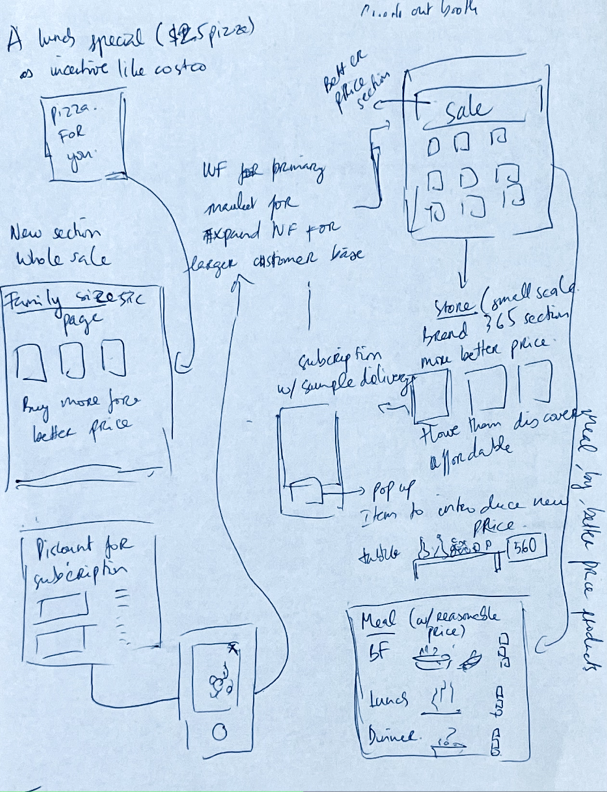Prime Grocery
A subscription-based grocery delivery service that provides fresh, affordable food delivered weekly to customers' doorsteps

About the project
This UX project aims to develop a subscription-based grocery service. The service will allow customers to schedule repeat purchases at their convenience while enjoying discounted prices.
This service is designed to cater to busy individuals who require weekly grocery purchases but wish to save both time and money. Through this project, we aim to enhance the user experience by providing a seamless and intuitive grocery shopping experience for Whole Foods Market customers.
My role
I was part of a two-person team and involved throughout the process of project, leading the ideation and prototype phases.

The problem

Source: https://www.statista.com/
Crowded aisles, lengthy checkout queues, and the struggle to find specific items can make the idea of going to a grocery store overwhelming.
One of the most frustrating experiences is completing a grocery shopping trip, only to discover upon returning home and unpacking that a crucial food or drink item was forgotten.
Introducing our solution
Prime Grocery
Introducing our Subscription Grocery Shopping feature: effortlessly set up recurring purchases, save time, and enjoy cost savings with automated delivery and customizable options.


Recurring purchases:
Users can subscribe to essential grocery and household items.
Subscription Management
Users can easily manage their subscriptions, including selecting delivery frequency, modifying product selections, and adjusting delivery dates.
Personal recommendation
Users receive tailored product recommendations based on their preferences and purchase history
Competitive pricing
Subscribers enjoy better pricing due to ordering in bulk quantities
Automate processing
The program automatically generates orders based on users' preferences and delivery schedules
Benefits for customers
Convenience
Saves time and effort through automated reordering
Cost savings
Save money on their grocery expenses
Customization
Allows users to modify items and adjust delivery frequency
Seamless Experience
Intuitive ordering processes and reliable delivery services
Opportunity for business
Increased customer loyalty and revenue.
Improved inventory management.
Enhanced customer data and insights.
Competitive advantage.
Long-term customer relationships.
User Research
To address shopper pain points, I conducted a contextual inquiry with a team member, observing and documenting the shopping journeys of three users at physical grocery stores like Whole Foods and Costco. This step identified key pain points and areas for improvement in the grocery shopping experience. We collect some very meaningful data during these trips
Key insights
Shoppers prioritize value when making purchasing decisions
Users value convenience and time-saving while shopping.
Some users have specific items they regularly purchase and prefer a repeat purchase option.
Users still prioritize healthy produce, but also consider pricing.
Challenges deep-dive
We did affinity diagrams help to organize and categorize research insights and data, identifying common themes and patterns in user feedback. By incorporating these components into the data model, the design team can ensure that the subscription service is user-focused, aligned with business objectives, and feasible to implement.

Meet our persona
User personas provide a detailed description of the target audience for the subscription service, including demographics, behavior patterns, pain points, and needs.

Question for us to solve
How might we create a shopping experience for grocery customers that offers both convenience and cost savings?
Ideation
After gathering insights from observing the shopper, the ideation process involves generating diverse ideas through brainstorming sessions, sketching, and paper prototyping.
Brainstorming: In this phase, I generate numerous ideas related to the design challenge or problem.

Describe your image

Describe your image

Describe your image

Describe your image
Storyboarding: I explore this methods to visually map out some of the concepts for the product

Describe your image

Describe your image

Describe your image

Describe your image
Paper prototyping: At first, we explored the idea of in-store shopping, enabling users to scan items and pay instantly. Yet, after user testing and design refinement, we shifted focus to better meet customer needs and business goals. Additionally, I devised another scenario centered on offering a convenient and cost-saving experience via subscription-based online grocery shopping.

Flow diagram and prototype
n this scenario, the user receives a notification regarding their upcoming grocery subscription delivery. Upon clicking to review the delivery details, they opt to add an item to their order. Following the addition of the item, they confirm the changes to their subscription.

Prototype
Testing our product on real shoppers
We run a moderate user testing on this prototype, followed by feedback sessions to gather valuable insights, aiding in the validation of assumptions.
-
Users quickly grasp and learn how to use the product design.
-
Unclear next steps after notification click
-
Difficulty adding to closest delivery
-
Lack of index button for navigation

Describe your image

Describe your image

Describe your image

Describe your image
Next steps
The next steps after user testing include analyzing feedback, iterating the design, conducting further testing if needed, collaborating with stakeholders, refining the user experience, and incorporating feedback into the design process.